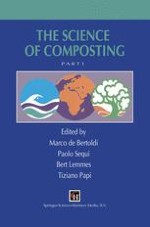1996 | OriginalPaper | Chapter
Olive-mill Wastewater Bioremediation: Evolution of a Composting Process and Agronomic Value of the End Product
Authors : U. Tomati, E. Galli, L. Pasetti, E. Volterra
Published in: The Science of Composting
Publisher: Springer Netherlands
Included in: Professional Book Archive
Activate our intelligent search to find suitable subject content or patents.
Select sections of text to find matching patents with Artificial Intelligence. powered by
Select sections of text to find additional relevant content using AI-assisted search. powered by
Olive-mill wastewaters (O.M.W.) were composted with wheat straw in a forced aereation static pile (7.5 × 2.5 × 1.8 m). To eliminate most of the liquid component and to degrade lignin, the thermophilic phase was prolonged for 5–6 weeks, adding O.M.W. every three days. At the end of the process, the ratio O.M.W./ solid substrate was about 10 litres per kg of straw. This paper discusses the bioremediation process from the standpoint of ligninolysis, humification, phenol degradation, phytotoxicity and agronomic value. The end product presented a degree of humification of 78%, and a residual lignin content of 30%. Soluble lignin fraction, made evident during the thermophilic phase, decreased during compost maturation. No phenols or phytotoxicity were detected in the end product. Pot and field experiments performed on maize, rye grass and horticultural plants indicated that bioremediated O.M.W. are able to support partially or totally the nutritional needs of cultures, at the same time improving soil properties.
